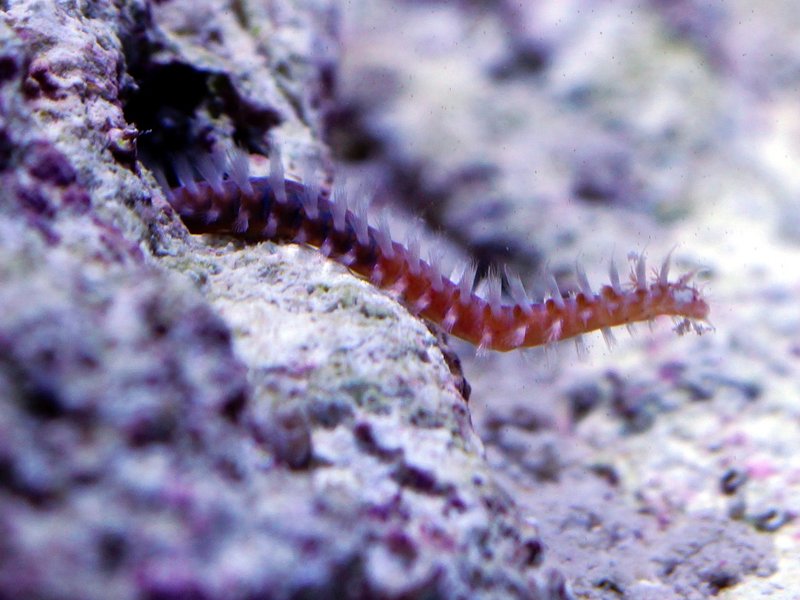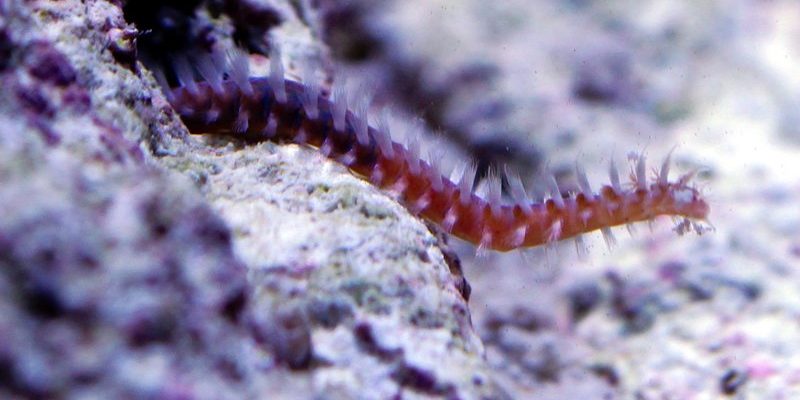
Bristle worms are fascinating creatures, but they can become a nuisance in your aquarium if their population isn’t kept in check. Imagine them as tiny, furry roadies for your aquarium—helpful in moderation but a bit overwhelming if they take over. Let’s dive into how these worms invade, their effects on your tank, and what you can do to manage their populations effectively.
What Are Bristle Worms?
Bristle worms are part of the polychaete group of annelids. These worms usually come in a variety of colors, often displaying a reddish-brown or green hue, and can grow anywhere from a few inches to nearly a foot long. What sets bristle worms apart is their bristles—hair-like structures covering their bodies. These bristles can sting if you touch them, so handle with care!
You might be wondering how they get into your aquarium in the first place. Often, bristle worms hitch a ride on live rock or coral. If you’ve recently introduced new aquarium decorations or livestock, there’s a chance they’ve brought along some unwelcome guests. They can also come through the substrate, eggs or larvae sneaking in with live sand, for instance.
How Do Bristle Worms Invade Your Aquarium?
Bristle worms have several cunning ways of invading your saltwater aquarium. One of the most common methods is through live rock. When you set up your aquarium, the live rock you buy may already have these worms living in it. Because they are so adept at hiding, you might not notice them until they’ve settled in and started multiplying.
Another way they invade is through contaminated substrate. If you’re using live sand or substrate from untested sources, bristle worm eggs or larvae can latch onto your aquarium. Once introduced, they can quickly find the perfect spots to burrow and hide, making them difficult to eliminate.
Honestly, bristle worms can also come in attached to fish, corals, or invertebrates that you add to your tank. It’s always a good idea to quarantine new additions for a bit before introducing them to your main tank. Doing this helps ensure you don’t accidentally transfer pests along with your new aquatic friends.
Why Should You Be Concerned About Bristle Worms?
You might think, “What’s the big deal? They’re just worms!” But here’s the thing: while bristle worms can play a role in maintaining your aquarium’s ecosystem by eating detritus and leftover food, an overpopulation can lead to significant issues.
With their rapid breeding rate, they can quickly grow in numbers, outcompeting your other beneficial organisms for resources. This can lead to unhealthy water conditions, increased waste, and even hostility among tank inhabitants. Not to mention, if they run out of food, they might start feasting on your corals or the fauna in your tank, putting your entire aquarium at risk.
Bristle worms can also become a nuisance during aquarium maintenance. Their long, bristly bodies can be difficult to catch or remove. Plus, their defensive bristles can irritate your skin, so it’s essential to be cautious while handling them.
How to Identify Bristle Worms in Your Aquarium
Identifying bristle worms may seem tricky at first, but once you know what to look for, it becomes easier. These worms often come out at night, making them more visible during dim conditions. You may spot them curling in and out of rocks or emerging from the sand during feeding times.
Another way to spot them is by their characteristic bristles. As they move, you’ll notice tiny hair-like structures that can catch light, making them sparkle. If you see these coming from hidden spots, you’re likely dealing with a bristle worm.
If you’re unsure whether what you’re seeing is a bristle worm or something else, you can try using a flashlight in low-light conditions or wait until feeding time when they are more active. Just remember to be gentle when checking out your tank inhabitants to avoid startling them too much.
How to Control Bristle Worm Populations
If you’ve decided bristle worms are taking over your aquarium, you might be wondering how to manage their numbers effectively. First and foremost, regular monitoring is key. Keeping an eye on their population will help you catch any rapid growth before it becomes a bigger problem.
One approach is to reduce the amount of leftover food in your tank. Bristle worms thrive on uneaten fish food, so ensure you’re not overfeeding your fish and other critters. It’s a good idea to do regular clean-ups, vacuuming any debris and removing excess feed that lands on the substrate.
Another method to control their population is introducing natural predators. Certain fish species, such as wrasses, love to munch on bristle worms. They can be a fun addition to your tank while also helping keep those worm numbers in check.
Natural Remedies for Elimination
If you’re facing an overwhelming bristle worm infestation, there are natural elimination tactics you can try. You might consider using traps designed specifically for these worms. Commercial options are available, but you can also create a simple DIY trap using a small container or jar filled with bait, like a piece of shrimp or fish. Place the trap near areas where you’ve spotted the worms, and check it regularly.
Another beneficial approach is to introduce more competitors into your tank. Encouraging a diverse range of organisms can help keep the bristle worms’ population under control. For instance, adding animals such as hermit crabs or peppermint shrimp can create competition for food and space.
Also, regularly removing any visible bristle worms during tank maintenance can help decrease their numbers. Just remember to wear gloves to avoid irritation from their bristles!
Prevention is Key
As the old saying goes, “An ounce of prevention is worth a pound of cure.” To keep bristle worms at bay, focus on prevention rather than dealing with a full-blown invasion. Here are some effective strategies:
- Quarantine New Additions: Always quarantine new fish, corals, or invertebrates for a few weeks before placing them in your main tank. This helps ensure you’re not introducing pests.
- Inspect Live Rock and Sand: Before adding any live rock or substrate to your aquarium, inspect it carefully for any signs of unwanted guests.
- Maintain Good Water Quality: Healthy water quality contributes to better overall tank health, reducing the chances of pest infestations.
- Be Mindful of Feeding Habits: Avoid overfeeding, as excess food attracts and nourishes bristle worms.
Taking these precautions not only helps keep bristle worms in check but also fosters a healthier environment for your aquatic pets.
In conclusion, while bristle worms can add a bit of mystery to your saltwater aquarium, it’s crucial to maintain a balanced ecosystem. By understanding how they invade and taking proactive steps, you can ensure your tank remains a thriving and visually appealing underwater world. Keeping an eye on their population, practicing good hygiene, and being smart about new additions will help keep those uninvited guests to a minimum. Happy fishkeeping!

